If you're an e-commerce business owner or marketing manager, you know how important having a solid online presence is. One of the most effective ways to drive traffic and conversions is through Google Ads.
Google Performance Max campaigns are a relatively new campaign type recently gaining popularity. While there are definite advantages to using Performance Max campaigns, there are also some potential drawbacks that you should be aware of.
This blog post will discuss the pros and cons of Google Performance Max campaigns for e-commerce advertisers. So, whether you're considering using this campaign type or want to learn more about it, keep reading to discover everything you need.
What are Google Ads Performance Max campaigns?
Google Ads Performance Max campaigns are a new type of campaign that allows advertisers to define a goal to maximise conversions or revenue and set a constraint, such as a target cost per sale or return on ad spend. Once you've set your goal and controls, you provide all of the ad content called assets and information about what you're advertising. Google then uses its machine learning algorithms to auto-generate ads that can serve across all available placements. Our post about Getting Started With Performance Max is a valuable resource if you're starting with Performance Max.
This is what makes Performance Max campaigns unique. They allow you to reach potential customers across all of Google's networks, including Search ads, Shopping, YouTube, Display network, and Discovery. Performance Max campaigns can optimise your ads and placements using machine learning to drive the best possible results for your business.
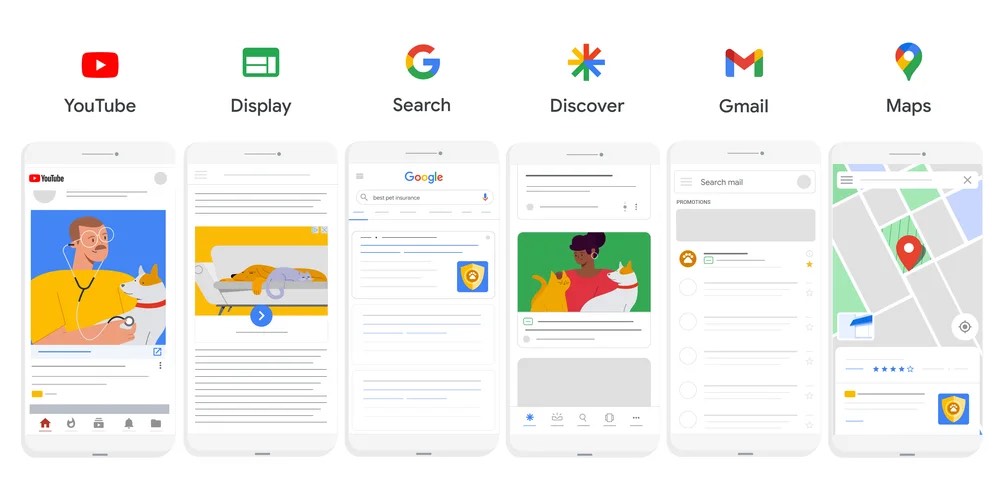
Should You Be Using Performance Max Campaigns For E-Commerce?
Now that we've covered what Google Ads Performance Max campaigns are, the question arises of whether they suit your e-commerce business. The answer depends on your specific goals and needs.
One of the main Performance Max benefits is that they're goal-based, best used when you have specific conversion goals, such as online sales. Additionally, Performance Max includes shopping ads, which are great for capturing bottom-of-the-funnel sales. This makes it an ideal campaign type for e-commerce businesses that rely on online sales to drive revenue.
Performance Max Can Decode Long Customer Journeys
Due to the inventory of some E-commerce stores, they typically have long customer journeys involving multiple touchpoints before a sale occurs. Performance Max campaigns are great at decoding this journey and identifying where your potential customers are in the funnel. By doing so, they can show up earlier in the customer journey and increase the likelihood of a sale.
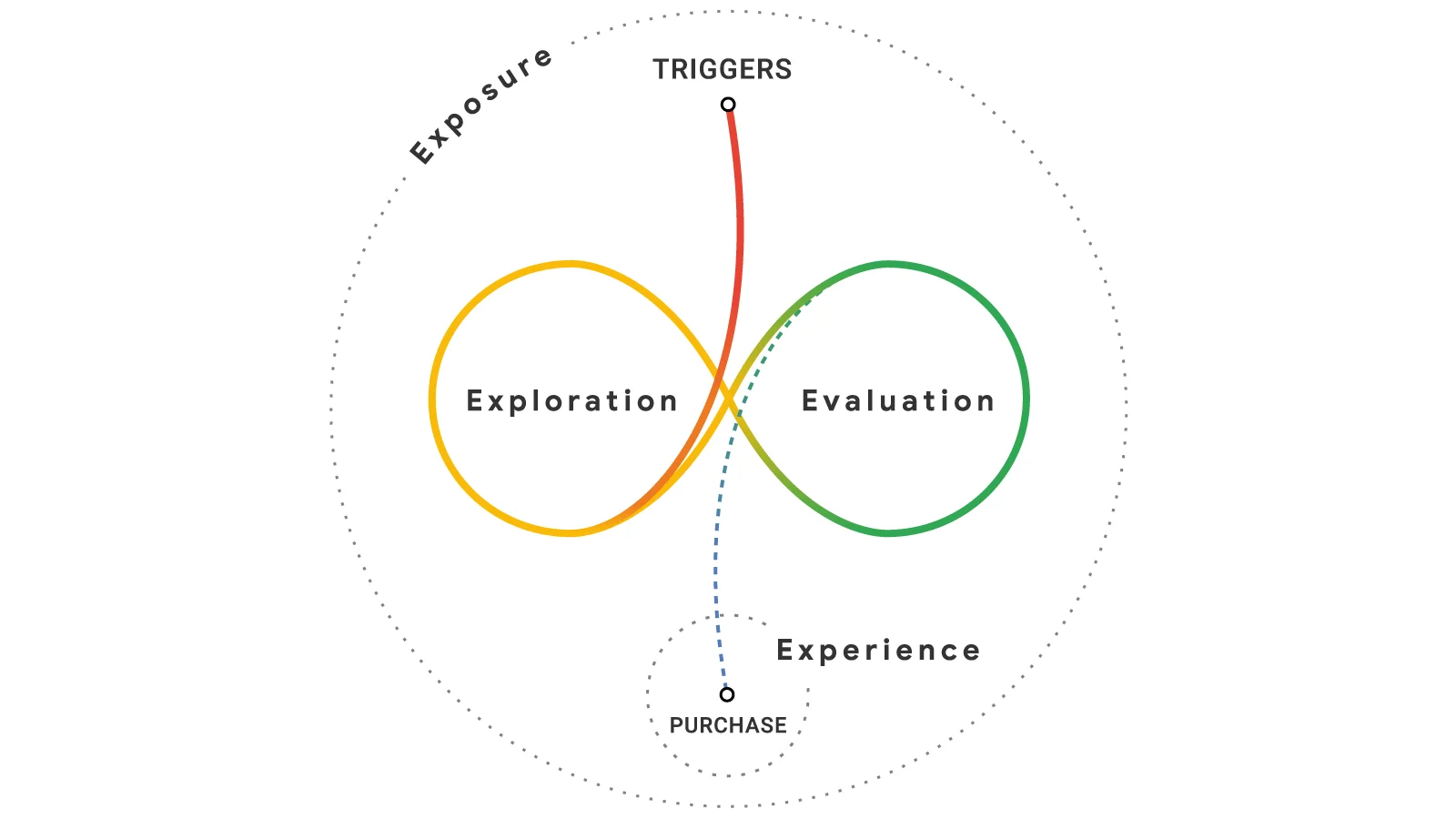
As Performance Max is designed to run across all of Google's ad inventory and optimise in real-time, this means that Performance Max can help e-commerce businesses achieve their conversion goals more efficiently by delivering the extra touchpoints needed to convert.
In the next section, we will dive deeper into Performance Max pros and cons for your e-commerce business, so you can decide whether this campaign type is right for you.
The Pros & Cons Of Google Performance Max
The goal of Google Ads Performance Max campaigns is to provide greater end-to-end efficiency for advertisers. This campaign type achieves this by streamlining marketing strategy, processes, and workflows, increasing the value of ad spend, and optimising conversion opportunities. Additionally, Performance Max makes all of Google's ad networks more accessible and aids advertisers who might otherwise be overwhelmed by the plethora of options available.
So, instead of manually creating and managing separate campaigns for each network, Performance Max allows you to streamline your advertising efforts and take advantage of the full range of Google's advertising capabilities.
What Are The Benefits Of Performance Max?
Performance Max Campaigns Reach a Wide Audience & Offer Full Funnel Coverage
Performance Max campaigns provide full funnel coverage across various channels and networks without creating and managing several types of campaigns, making it easier for businesses to reach a wider audience. As mentioned, this campaign optimises conversion opportunities and streamlines marketing strategies, enabling enterprises to maximise ad spend. With Performance Max, companies can leverage the power of Google's extensive inventory to reach customers at every funnel stage.
Automation Does Most Of The Heavy Lifting
Performance Max campaigns use machine learning algorithms to identify the best audiences for your business and the best ad formats and placements. Google Ads AI and automation take most of the heavy lifting, so you don't have to spend hours optimising your campaigns. This means you can focus on other essential aspects of your campaigns.
In addition, Performance Max campaigns have a unique feature called Asset Groups, which allows you to group your creative assets (such as images, headlines, and descriptions) by themes and formats based on the audience signals you provide (more on this shortly). Google Ads uses these Asset Groups to generate and test different ad variations across all available ad formats and placements. This helps you to achieve maximum reach and coverage with minimal effort.
Automated Video Creation
Additionally, Performance Max can leverage video assets that an advertiser already has, such as product demos or promotional videos. However, if these are not available, fear not. Performance Max can use your text and image assets to automatically create video ads that align with your brand's look and feel. The platform can then target these videos to audiences most likely to engage with them.
This feature can help businesses hesitant to create their video ads while still providing them with the benefits of running them on YouTube. Furthermore, Google's automated video creation can help businesses save time and money otherwise spent on creating professional-quality video ads.
Location & Ad Schedule Visibility
Performance Max campaigns allow for location targeting and ad schedule adjustments, a huge advantage for businesses targeting specific areas or times. With location targeting, you can choose the geographic areas where you want your ads to appear, such as by city, state, or even zip code. This feature is particularly useful for businesses with physical locations or serving specific geographic regions.
Ad schedule adjustments allow you to control when your ads appear during the day or week, so you can turn off your ads during specific times, such as weekends or outside business hours. This is particularly useful for businesses that want to target customers during their peak hours or when they're most likely to convert.
While Performance Max campaigns may offer fewer optimisation and insight opportunities than channel-specific campaigns, this feature is similar in its function to standard Google Ad campaigns. The location and ad schedule adjustments make it easier for businesses to target their ideal customers and maximise their ad spend. It is important to remember that Performance Max is a goal-based campaign type, so companies should be clear on their specific conversion goals and monitor their campaigns closely to ensure they achieve their objectives.
Assets & Optimisation Information Isn't Siloed In Performance Max Campaigns
Performance Max also offers a unified view of all your ad assets, allowing for the efficient optimisation of your campaigns. Rather than analysing and optimising individual ad types separately, you can change your assets, targeting, or bidding strategy for all channels in one go.
This can save time and effort compared to managing separate campaigns for each ad type. Moreover, with the help of Google's machine learning algorithms, Performance Max can quickly test and optimise different combinations of your assets to determine the most effective ad format and messaging with a view of all touchpoints across the other networks, optimising messaging and timing accordingly.
This ultimately leads to better overall performance and return on investment for your campaigns, as this isn't possible with standard campaigns.
AI Will Identify & Scale Into New Opportunities
Performance Max campaigns use machine learning algorithms to optimise real-time ad delivery. This means that the algorithms work to show your ads to the most relevant and likely to convert users, ultimately helping to increase your conversion volume.
As a result, the system continuously seeks new opportunities across all networks. Hence, this entails probing new audiences that might yield more sales based on what it learns from the audiences it already targets and sees success with. The ads are refined automatically, allowing the system to identify the best-performing creative, audiences and ad combinations.
Furthermore, Performance Max automates the traditional A/B testing of your creative, making it easier for you to optimise your campaigns for better performance. With all of these features, Performance Max allows you to take a more hands-off approach to ad optimisation and instead lets the system do the heavy lifting for you.

Free Report
Spot Errors, See Strategies,
Our Free Report Reveals Key E-Commerce Fixes.
Book Your Call
Performance Max Can Work Alongside Standard Google Search Ad Campaigns
Performance Max campaigns can complement your keyword-based search campaigns, helping you find more conversions across Google's channels. As a result, wins in your search campaigns can educate the algorithms in Performance Max. By learning from the conversion data in your other ad campaigns, Performance Max can improve its performance over time.
Moreover, Performance Max can also be utilised as a Smart Shopping campaign, making it perfect to set up alongside search ad campaigns if you want to maintain more control over your search ads. If you are looking for guidance on setting up Performance Max as a Smart Shopping campaign only, we have this covered in another post, so head over to learn more about Performance Max Smart Shopping.
Overall, collaborating with other types of ads can make it easier to achieve your business goals as long as every aspect is aligned with your business targets.
Audience Signals Teach Performance Max Where To Find Customers
One of the critical benefits of Performance Max is its ability to utilise audience signals to find and target customers effectively. While Performance Max does not provide search term data, it heavily relies on audience targeting to deliver the right ad traffic to potential customers.
Advertisers can guide Google's machine learning algorithms by layering in audience groups, keywords, in-market audiences, and URLs of competitive or complementary websites, nudging Google's machine learning algorithms towards the desired direction.
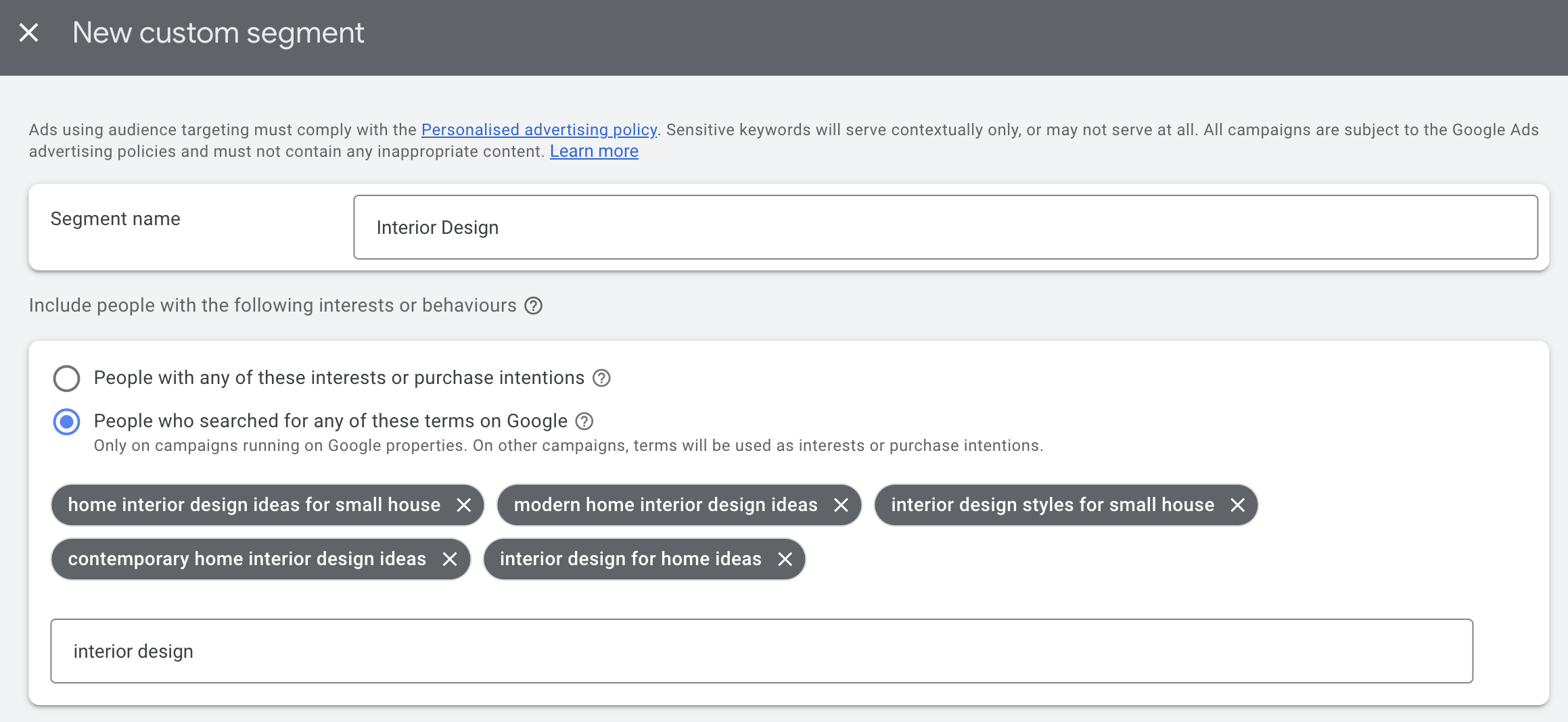
This is particularly helpful when starting a new Performance Max campaign. These additional signals help speed up the campaign's ramp-up period and deliver better results faster.
Overall, Performance Max offers a powerful way to optimise ad delivery to the right audiences and is an excellent tool for any business looking to scale its online advertising efforts. Read our Audience Signals In Performance Max guide for more guidance on this subject.
Use Insights To Expand Into New Audiences
The ability to educate Performance Max with audience signals can offer expansion opportunities. A valuable feature of Performance Max is the ability to gain insights into audience behaviour and preferences. These insights can be utilised to discover untapped audiences and create targeted asset groups with tailored ad messaging and website landing pages.
Reviewing audience data in the Performance Max campaigns Insights tab allows you to identify audiences you might have yet to consider when setting up your campaigns. Still, Google managed to identify them and add them to its targeting from the sales data it's been analysing and optimising from.
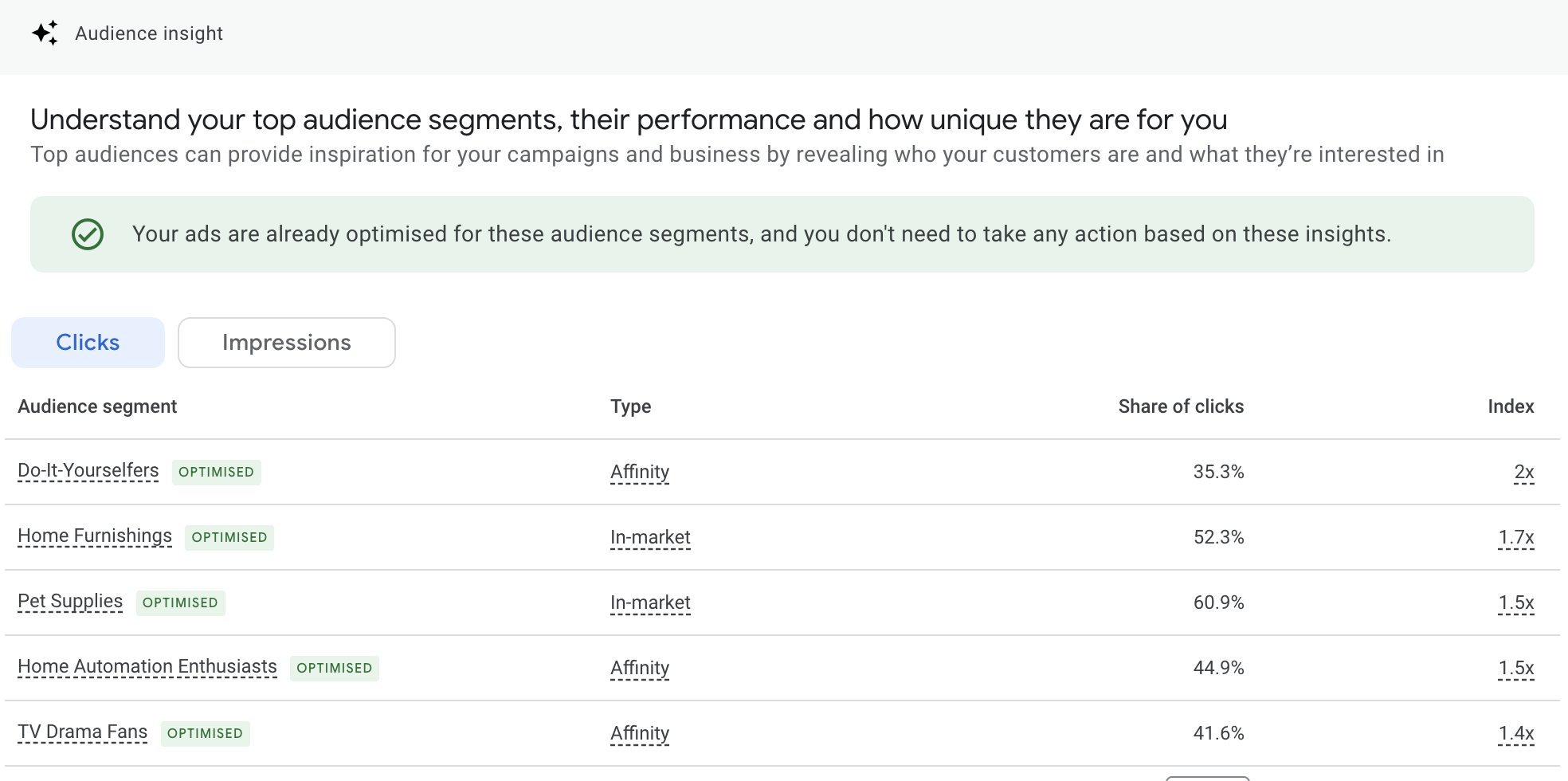
Overall, Performance Max's Audience Signals and the ability to analyse insights empower you to continuously refine your targeting strategies, discover new audiences, and scale your campaigns to reach a broader customer base. Which is precisely what Performance Max campaigns are supposed to do.
What are the cons of Performance Max?
While Performance Max campaigns offer numerous benefits, it's crucial to consider certain aspects before fully embracing this campaign type. Advertisers should carefully evaluate their desired level of control, the impact on other Google ad campaigns, and the budget and traffic considerations associated with Performance Max.
In some cases, a combination of Performance Max and standard Google Ad campaigns can offer a more balanced approach to achieving marketing objectives while maintaining control over specific aspects of the campaigns.
Here, we'll cover some of the drawbacks of Performance Max campaigns in more detail.
Performance Max Can Be Difficult To Setup Correctly
Setting up Performance Max campaigns can present challenges, particularly when determining the best approach for your business and structuring campaigns to optimise goals for different parts of your e-commerce product catalogue.
The complexity arises from the limited control and adjustments available during campaign setup and management, especially if you're not utilising an integrated eCommerce solution like Shopify that seamlessly integrates with Google Ads.
One of the complexities lies in accurately tracking conversions. An error in conversion tracking can significantly impact campaign performance, as Performance Max campaigns heavily rely on the stated objectives and the conversion data they measure. Therefore, it's crucial to ensure that conversion tracking is properly implemented and functioning correctly to avoid misleading campaign optimisation and misallocation of resources.
Additionally, the lack of granular control in Performance Max campaigns can add complexity. Unlike other campaign types, where advertisers can adjust targeting parameters, bid strategies, and ad creatives, Performance Max campaigns rely on Google's machine-learning algorithms for decision-making. This can make it challenging to fine-tune and optimise campaigns according to specific business needs, especially for advertisers who prefer more hands-on control.

Getting Started With
Performance Max
Download Our Step-by-step guide to getting started with Performance Max Shopping Campaigns for your Shopify Store
GET YOUR FREE EBOOKFREE EBOOK
Lack of Campaign Controls In Performance Max
On the subject of campaign controls, Performance Max campaigns may leave some advertisers feeling limited in their ability to optimise and fine-tune variables. If you're familiar with standard Google Ad campaign types, you'll notice that many familiar functionalities are missing from Performance Max. This can be frustrating for advertisers who prefer a more hands-on approach and are accustomed to having greater control over their campaigns.
For example, selecting different bid strategies for various asset groups within a single campaign in Performance Max campaigns is impossible. Bid strategies are determined at the campaign level, emphasising the importance of proper campaign structuring to align with your objectives. Manual bidding at the keyword or SKU level is not an option.
The reduced level of control in Performance Max can make it easier to spend money with Google. With a vast ad inventory, the potential to spend significant amounts can be high if advertisers don't narrow down their targeting effectively. While this benefits Google, it may only sometimes align with the advertiser's goals and desired return on investment.
Advertisers with specific budget constraints, language preferences, geographical targeting needs, or unique bidding strategies may find the lack of control in Performance Max campaigns to be limiting. Performance Max primarily focuses on bidding strategies prioritising conversions and revenue, which may not always suit these situations. Advertisers may find more control and flexibility by opting for standard search ad campaigns or adopting an optimised Performance Max campaign structure that allows for a more granular objective setting tailored to product margins and specific sales objectives. However, it's important to note that increased control comes with increased complexity and the need to structure the campaign to achieve the desired outcomes carefully.
For those seeking further guidance on creating effective Performance Max campaign strategies for e-commerce success, we have a comprehensive post on our website that provides valuable insights and strategies. You can explore it here: Unleash the Power of Performance Max: How to Create Strategies for E-commerce Success.
Lack Of Negative Keywords At The Campaign Level
One of the limitations in terms of campaign control in Performance Max is the need for negative keywords at the campaign level. This has implications for managing and optimising your ad targeting effectively.
Access to keyword and search term-level data is limited, and such data is only available in the insights tab and provides more generalised information for the entire campaign. This lack of specific search query data makes it challenging to take action with search query filtering using negative keywords. For instance, if you identify terms in the insights section that you want to avoid triggering your ads, you may need help addressing these concerns.
Adding negative keywords at the campaign level in Performance Max campaigns is impossible. You do have a couple of options, though each has some drawbacks depending on what other campaigns you have in your account.
One is to add negative keywords at the account level. However, implementing negative keywords this way would block those keywords for all campaigns within the account, limiting your ability to control the search query flow for different campaigns individually.
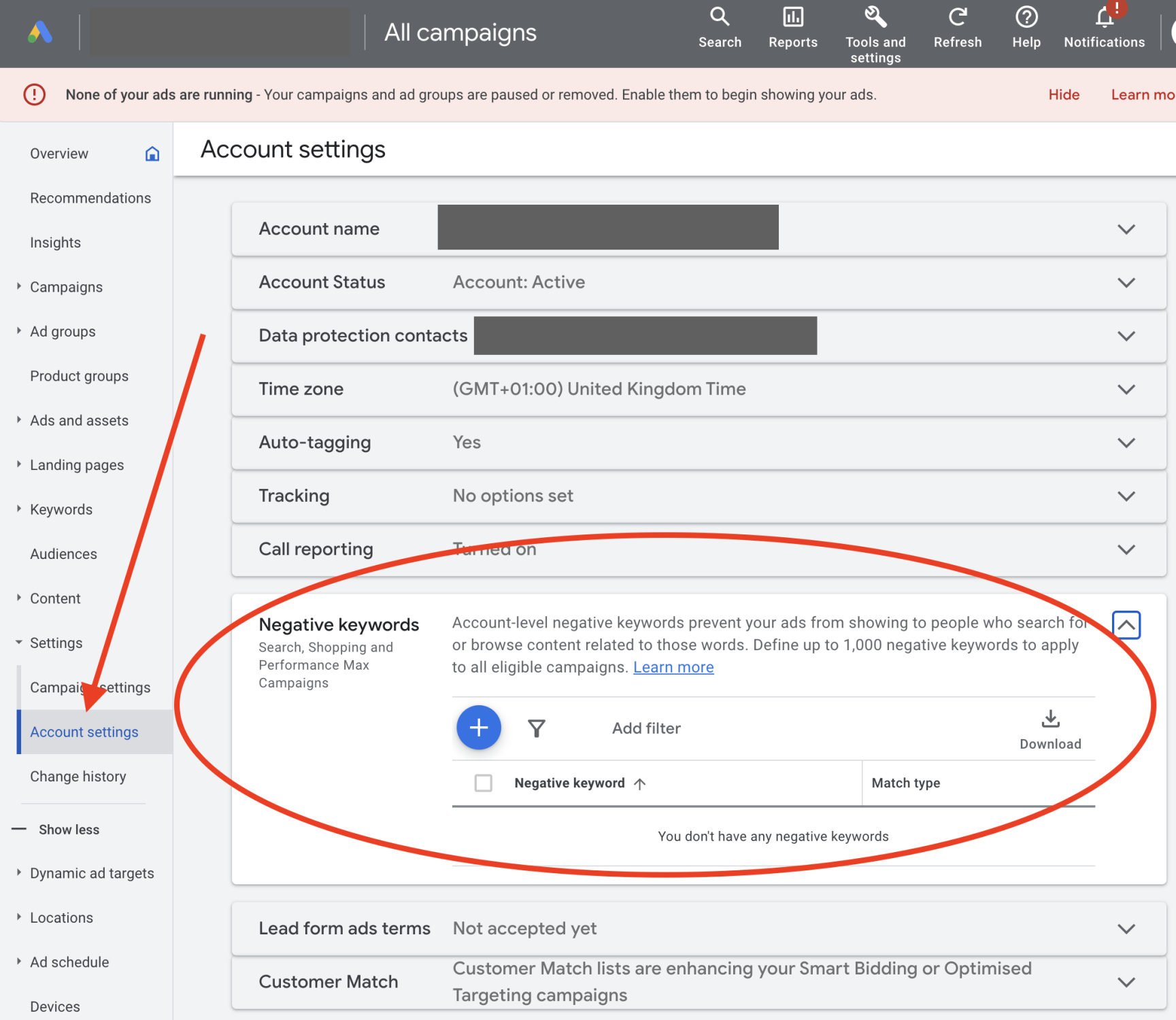
If you have a Google ad representative, you can work with them to create a list of negative keywords and request that they incorporate them into your campaigns. This can help mitigate challenges posed by the lack of campaign-level negative keyword control in Performance Max.
Limited Bid Options In Performance Max
Another area where Performance Max campaigns have limited control is bid options. Performance Max might not be ideal if you were expecting more flexibility in your budget or setting specific cost-per-click (CPC) limits. Unlike some channel-specific campaigns, Performance Max does not provide any form of bid limiting or cost-per-click bid control.

In comparison, standard campaigns offer the feature of controlling bid limits, even for Smart Bidding strategies, when added to a portfolio. However, this level of control is not available within Performance Max campaigns.
If you require more granular control over your bids or if setting specific CPC limits is a critical aspect of your advertising strategy, exploring alternative campaign types may be necessary.
Traffic By Device Limitation
Currently, Performance Max campaigns do not allow the implementation of device modifiers, and this means you cannot adjust bids specifically for different devices such as mobile, desktop, or tablets. This limitation restricts your ability to fine-tune your campaign performance based on device-specific behaviour.
While direct control over device bid modifiers is not available, monitoring specific metrics related to device performance is still possible. By utilising analytics and tracking tools, you can gain visibility into device-specific data and identify patterns or trends that might explain variations in sales or other key performance indicators.
We offer some guidance on this in another blog post, with a section specifically on Traffic By Device Reporting For Performance Max.
Performance Max Will Ignore Some Products
Following on from the subject of limited bid strategy options, bidding is set at the campaign level rather than for individual ad groups or SKUs. This approach allows PMax to prioritise campaigns based on overall goals, focusing on driving conversions and achieving target ROAS or cost-per-sale metrics. However, this means that Performance Max may occasionally overlook products that attract low traffic and conversions, only allocating resources to those more likely to convert successfully.
The consequence of this prioritisation is that certain products may go unnoticed and miss the opportunity to shine within Performance Max. With limited traffic allocated to them, they may not receive the exposure they deserve.
Specific interventions are necessary to address this issue and ensure maximum visibility for all products. One approach is isolating new and low-traffic products within separate campaigns and implementing a more aggressive bid strategy. By doing so, you provide them with a better chance to generate traffic and conversions.
Performance Max Can Harm Other Google Campaign Types
It's essential to consider the impact of Performance Max (PMax) campaigns on other campaign types. Google Performance Max campaigns have the highest priority for traffic over any other Google Ad campaigns, with a few exceptions. As a result, you may come across instances where Performance Max campaigns "steal" performance metrics from other campaigns. This occurs when Google determines that your Performance Max ad is more relevant and has a higher ad rank than your search ads or different campaign types.
The exception is when you have standard search ad campaigns which use exact-match keywords. So to mitigate this, it is recommended to include exact-match keywords in your existing search campaigns. Exact match keywords take priority over Performance Max campaigns, helping to ensure that your desired traffic is directed to the intended campaign. However, it's important to note that there are no guarantees that PMax won't still impact your search ad traffic.
In the case of Shopping Campaigns, if a product is included in both a standard shopping campaign and a Performance Max campaign, the standard shopping ads won't receive any impressions. This is because Performance Max campaigns take precedence as the highest priority campaigns. To fully appreciate the nuances of Performance Max campaigns, it's essential to comprehend how they stack up against traditional shopping campaigns, a topic we thoroughly explored in our dedicated post, Google Performance Max vs. Standard Shopping Campaigns.
Considering these factors, you should carefully monitor the performance and impact of Performance Max campaigns and closely evaluate the performance of overlapping campaigns to help minimise any potential adverse effects on traffic, click costs, and acquisition costs.
Lack Of Insights In Performance Max Campaigns
It's essential to address the limited reporting capabilities in Performance Max campaigns. While we'd encourage you to refer to our comprehensive blog post on navigating Performance Max Analytics for more in-depth information, here's a brief overview of reporting limitations.
You can generate reports on top-level performance metrics like other campaigns, including impressions, clicks, conversions, and cost. However, the available insights could be improved when delving deeper into the data.
While Google has improved the Insights Tab since the introduction of Performance Max, essential insights still need to be included, and advertisers may find it challenging to obtain the granularity of data they need to make informed decisions. We may see further improvements in reporting capabilities as Performance Max evolves. Nonetheless, knowing the current limitations and leveraging other analytical tools and strategies is essential to comprehensively understand your PMax campaign performance.
It's Difficult to Identify Sources Of Traffic & Sales In Performance Max
Understanding where your ads are showing and which specific keywords or audiences are driving performance can only be possible by making your calculations. Similarly, it's challenging to determine the effectiveness of your budget allocation between search and shopping ads, hindering your ability to assess cost efficiency.
There is little visibility on channel-specific performance, so it is difficult to know if your Shopping Ads in Performance Max are doing all the heavy lifting, with any spending elsewhere a wasted effort.
The Insights Tab provides a view of data for search queries and audiences. Joining the dots with ad copy and audience signals depends on how you've structured your asset groups. But this doesn't offer insight into which channels are performing and which are wasting some of the budgets. Low volume can also pose a problem, as this data can become distorted.
Well-Defined Goals Are Essential For Performance Max To Work
Advertisers must have a clear understanding of specific figures. These figures will vary depending on the goal you set for your campaign and how you measure success. But before implementing the correct strategy, you must know your break-even ROAS (Return On Ad Spend). Or, in the case of cost-per-sale goals, what is your break-even cost per sale is. And, with these in mind, does this change upon the acquisition of new customers?
Implementing the correct strategy with a solid grasp of these figures and the variations based on different customer segments becomes easier. The lack of clarity may lead to parts of your campaign operating at a loss or missing out on crucial opportunities for customer acquisition.
Lack of SKU Level Data In Performance Max
It's important to note that accessing SKU-level data is not as straightforward as in Standard Shopping or the now-retired Smart Shopping campaigns. In Performance Max, you are limited to expanding listing groups representing product SKUs up to 1,000 SKUs per campaign. This limitation can pose a challenge for e-commerce advertisers who have a more extensive inventory.
Suppose you want to dive into the nitty-gritty details of SKU-level data and have over 1,000 SKUs. In that case, you won't be able to break out your listing groups sufficiently within the campaign structure to see this data at the campaign level. This limitation can make it challenging to analyse and optimise performance at the individual product SKU level, which may be necessary for e-commerce businesses with a diverse range of products.
The recommended solution is to utilise SKU reporting in Google Ads Reports to gain insights into SKU-level data. By applying the appropriate filters and configuring the reports, you can obtain more granular information about your SKUs and their performance. This lets you understand which products drive results and make data-driven decisions to optimise your advertising efforts.
Are Google Ads Performance Max Campaigns Worth It?
In conclusion, Performance Max has received mixed reviews from advertisers, with different opinions and concerns. Some advertisers may resist Performance Max due to a dislike of change. In contrast, others may be frustrated by the perceived lack of control. There may also be concerns among Google Ads agencies that Performance Max could render their services obsolete. However, it's essential to recognise that, like any PPC Ads campaign, Performance Max requires strategic structuring and ongoing attention to ensure efficiency and alignment with business goals. Agencies can be crucial in decoding data, providing advice, and developing strategies that meet each business's unique needs.
Performance Max can be a valuable entry point into Google Ads for first-time advertisers, offering an easy way to reach various advertising properties. It can provide a good starting point for businesses to establish their online presence and generate initial results. However, it's essential to understand that Performance Max is not a set-it-and-forget-it solution. Regular reviews and optimisation are necessary to ensure long-term success. Areas that require attention include maintaining the quality of the Shopping Feed, expanding and evolving audience targeting, and refreshing ad creative to avoid ad fatigue.
Despite its advantages and challenges, Performance Max should be considered a powerful tool in a comprehensive advertising strategy. It offers a broad reach across Google's advertising network and provides opportunities to reach new audiences. By combining the strengths of Performance Max with other campaign types and strategies, businesses can maximise their advertising effectiveness and achieve their desired outcomes.
In conclusion, Performance Max is a dynamic advertising solution that requires thoughtful planning, ongoing monitoring, and strategic optimisation. It is not a one-size-fits-all approach; Performance Max agencies are vital in guiding businesses through its complexities. By leveraging the benefits of PMax while addressing its limitations, advertisers can unlock its full potential and drive meaningful results for their campaigns.

Book A Discovery Call
Looking for tailor-made PPC strategies? Our team is here to help you maximize your online store's potential. Book a discovery call with us for personalised insights and solutions.
Book Your Free ConsultationBook Your Call